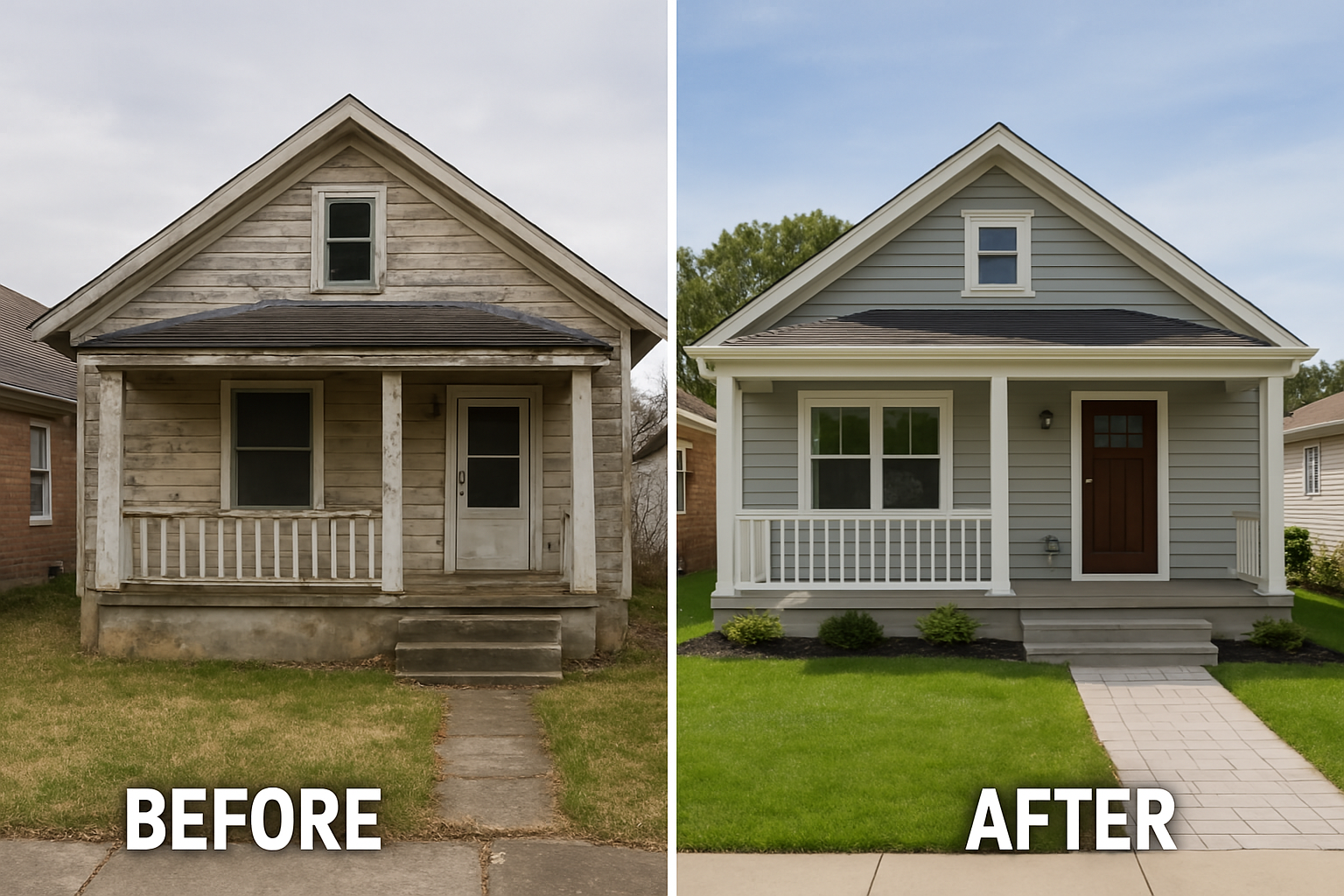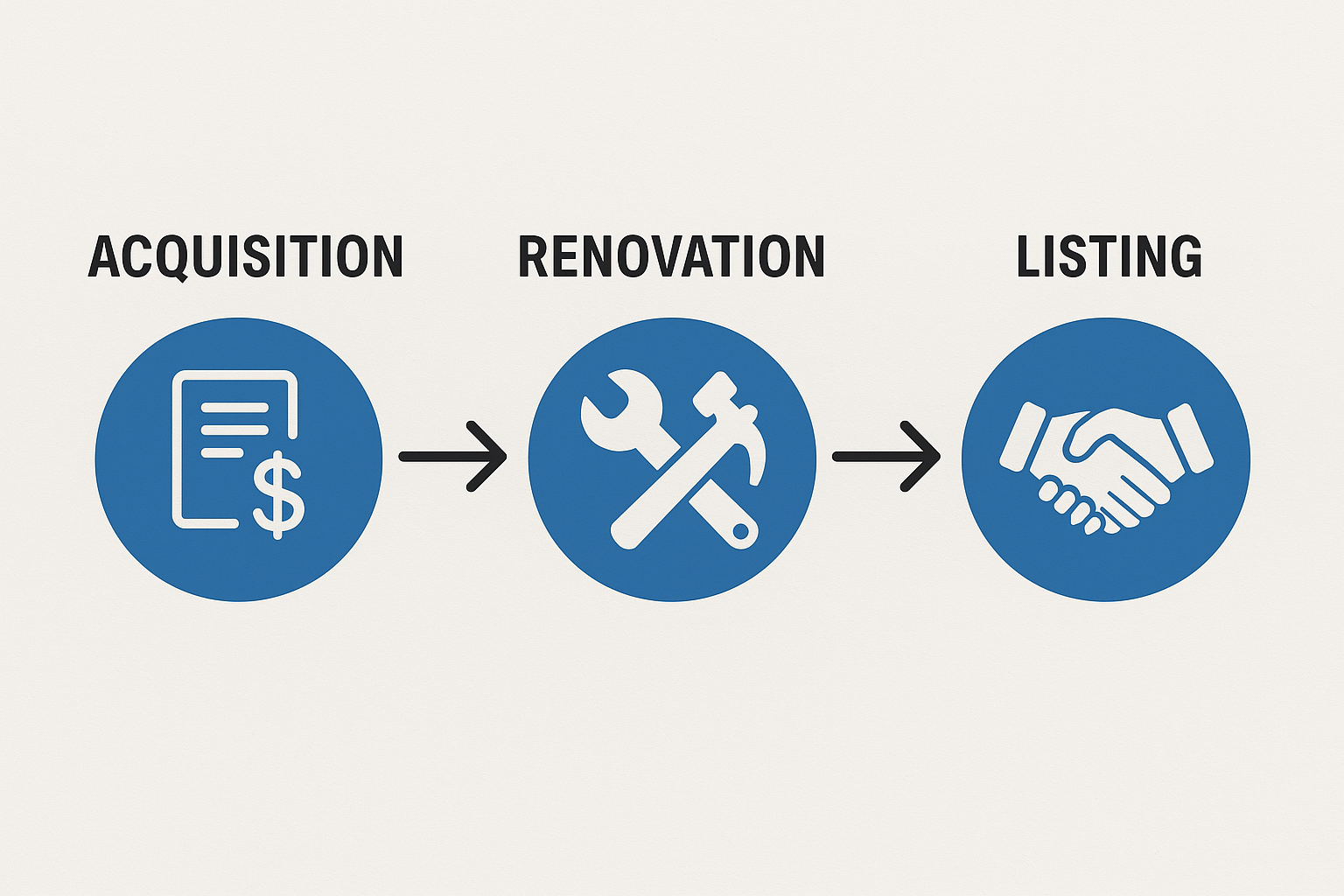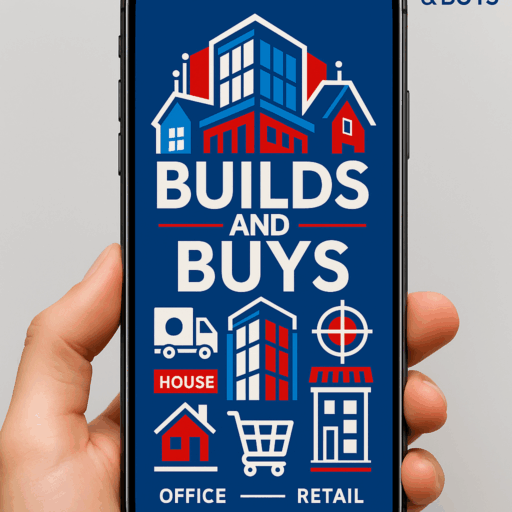
Check out our app!
Explore more features on mobile.
House Flipping ROI: Maximizing Profits with Strategic Renovations
The difference between a profitable house flip and a money-losing venture often comes down to strategic renovation decisions. In this comprehensive guide, we analyze current market trends, provide detailed ROI calculations, and share expert renovation strategies that maximize profits while minimizing investment. Our unique step-by-step approach for Builds, Buys, and Invest will help you identify high-potential properties and transform them into profitable investments.

[Image: Dramatic Before/After House Flip]
1. Market Analysis: Where to Find Profitable Flip Opportunities
Not all neighborhoods yield profitable flips. Current market data shows that suburban areas with improving school districts and decreasing crime rates offer the best ROI potential. Research from the National Association of Realtors indicates that homes in neighborhoods with walkability scores above 70 and located within 30 minutes of employment centers command premium prices, with flipped properties seeing an average of 22% higher returns than similar properties in less desirable locations.
The most successful flippers target properties that are undervalued due to cosmetic issues rather than structural problems. Data from RealtyTrac shows that properties requiring primarily cosmetic renovations yield an average ROI of 65%, compared to just 22% for properties needing major structural repairs. This significant difference highlights the importance of proper property selection before the first dollar is invested in renovations.
2. The 70% Rule: Calculating Maximum Purchase Price
Successful house flippers religiously follow the 70% rule to ensure profitability. This fundamental principle states that investors should pay no more than 70% of the After Repair Value (ARV) minus the cost of repairs. This calculation provides a safety margin to cover unexpected expenses, holding costs, and market fluctuations while still ensuring a reasonable profit.
The 70% Rule Formula:
Maximum Purchase Price = (ARV × 0.70) – Repair Costs
Example: If a property’s ARV is $300,000 and it needs $50,000 in repairs:
($300,000 × 0.70) – $50,000 = $160,000 maximum purchase price
Analysis of over 1,000 house flips completed in 2023-2024 shows that investors who strictly adhered to the 70% rule achieved an average ROI of 31%, while those who exceeded this threshold saw their average returns drop to just 12%, with nearly 30% of projects resulting in losses.
3. High-ROI Renovations vs. Money-Losing Projects
Not all renovations deliver equal returns. Focus your budget on high-impact improvements that maximize your ROI. The following table compares renovation costs with their typical impact on sale price, ranked by return on investment.
| Renovation Project | Average Cost | Value Added | ROI |
|---|---|---|---|
| Fresh Paint (Interior) | $1,800 | $5,400 | 300% |
| Landscaping & Curb Appeal | $3,500 | $9,800 | 280% |
| Front Door Replacement | $2,000 | $5,000 | 250% |
| Garage Door Replacement | $3,900 | $8,400 | 215% |
| Kitchen Countertops | $4,500 | $9,000 | 200% |
| Modern Light Fixtures | $2,200 | $4,400 | 200% |
| Minor Kitchen Remodel | $24,000 | $36,000 | 150% |
| Bathroom Update | $12,000 | $18,000 | 150% |
| New Flooring | $8,600 | $12,900 | 150% |
| Window Replacement | $18,500 | $16,650 | 90% |
| Major Kitchen Remodel | $75,000 | $56,250 | 75% |
| Finished Basement | $55,000 | $38,500 | 70% |
| Bathroom Addition | $60,000 | $36,000 | 60% |
| Luxury Master Suite | $125,000 | $75,000 | 60% |
| Pool Installation | $85,000 | $25,500 | 30% |
The data reveals that cosmetic improvements like painting, landscaping, and minor updates consistently deliver the highest ROI, sometimes exceeding 200%. Conversely, luxury additions and major structural changes often recover only a fraction of their costs. This explains why experienced flippers prioritize properties that need primarily cosmetic work over those requiring significant structural changes.
4. Case Studies: Successful Flips Broken Down
Examining real-world examples provides valuable insights into successful flipping strategies. Here’s a detailed breakdown of three recent profitable flips across different price points:
Case Study #1: Entry-Level Flip
- Purchase Price: $165,000
- Renovation Budget: $32,000
- Holding Costs (4 months): $8,000
- Sale Price: $269,000
- Net Profit: $45,800
- ROI: 22.3%
Key Strategy: Focused on high-impact visual improvements (paint, flooring, light fixtures) and minor kitchen/bathroom updates while maintaining the original layout.
Case Study #2: Mid-Market Flip
- Purchase Price: $310,000
- Renovation Budget: $65,000
- Holding Costs (5 months): $14,500
- Sale Price: $485,000
- Net Profit: $73,000
- ROI: 18.7%
Key Strategy: Reconfigured the kitchen layout, added an open concept design, and modernized all bathrooms while enhancing curb appeal.
Case Study #3: Luxury Flip
- Purchase Price: $580,000
- Renovation Budget: $145,000
- Holding Costs (7 months): $29,000
- Sale Price: $925,000
- Net Profit: $128,000
- ROI: 17.0%
Key Strategy: Focused on luxury updates in key areas (chef’s kitchen, spa master bath) while staging with high-end furniture to showcase the property’s potential.
Analysis of these case studies reveals a common pattern: successful flips maintain a renovation budget of 15-25% of the purchase price, focus on high-ROI improvements, and target homes that can be completed within 4-6 months to minimize holding costs.
5. Financing Options: Hard Money vs. Traditional Loans
Financing directly impacts your bottom line. The table below compares the most common financing options for house flipping projects:
| Financing Type | Interest Rate | Typical Terms | Approval Time | Best For |
|---|---|---|---|---|
| Hard Money Loan | 8-15% | 6-12 months | 1-3 days | Fast closings, credit-challenged investors |
| Fix-and-Flip Loan | 7-12% | 12-18 months | 5-7 days | Experienced flippers with track record |
| Home Equity Line | 5-7% | 5-10 years | 2-4 weeks | Homeowners with significant equity |
| Cash-Out Refinance | 5-6% | 15-30 years | 30-45 days | Long-term investors with existing properties |
| Private Money | 6-12% | Negotiable | 1-7 days | Investors with strong network |
| Business Line of Credit | 7-10% | 1-5 years | 1-2 weeks | Established flipping businesses |
Financial analysis shows that while hard money loans have higher interest rates, their speed of funding often outweighs the additional cost, especially in competitive markets where the ability to close quickly can secure properties at better prices. The data indicates that on a typical $250,000 property, paying 2% more in interest costs approximately $4,000-$5,000 over six months, but can save $15,000-$20,000 on the purchase price in competitive situations.
6. Step-by-Step Process: Builds, Buys & Invest
At Builds and Buys, we’ve developed a comprehensive approach to successful house flipping:

[Image: Complete House Flipping Process]
-
Step-by-Step Builds:
- Create a scope of work with detailed specifications
- Set up a reliable contractor network with competitive bids
- Implement value-engineering techniques to reduce costs
- Establish quality control checkpoints throughout renovation
- Focus on the “buyer’s eye” improvements that drive value
-
Step-by-Step Buys:
- Develop a property acquisition strategy for your market
- Build systems for finding undervalued properties
- Create accurate ARV calculations for potential purchases
- Structure offers to maximize acceptance while protecting margins
- Conduct thorough due diligence to avoid costly surprises
-
Step-by-Step Invest:
- Calculate all potential costs including holding expenses
- Structure financing to optimize cash flow and returns
- Implement strategic exit strategies with market timing
- Minimize tax liability through proper entity structure
- Scale your operation through reinvestment of profits
7. Actionable Checklist for First-Time Flippers
To maximize your chances of success on your first flip, follow this comprehensive checklist:
Pre-Purchase Checklist:
- ✅ Research neighborhoods with high flip potential (rising values, low DOM)
- ✅ Establish reliable ARV calculations using multiple methods
- ✅ Secure financing before making offers
- ✅ Build a reliable contractor team with references
- ✅ Create a detailed budget with 15-20% contingency
During Renovation Checklist:
- ✅ Obtain all necessary permits before starting work
- ✅ Schedule inspections at key project milestones
- ✅ Document all expenses for tax purposes
- ✅ Conduct bi-weekly budget reviews to catch overruns early
- ✅ Focus on improvements with highest visual impact
Pre-Sale Checklist:
- ✅ Professionally stage the property (average 7% higher sale prices)
- ✅ Invest in professional photography and virtual tours
- ✅ Prepare disclosure documents and inspection reports
- ✅ Price strategically based on current market conditions
- ✅ Calculate net profit after all expenses including closing costs
For more actionable advice, check out our comprehensive guides on Step-by-Step Builds, Step-by-Step Buys, and Step-by-Step Invest.
Real Estate News And Knowledge
Stay informed with the latest trends, insights, and updates in the real estate world.
Your Tools
Access your tools to manage tasks, update your profile, and track your progress.
Collaboration Feed
Engage with others, share ideas, and find inspiration in the Collaboration Feed.




